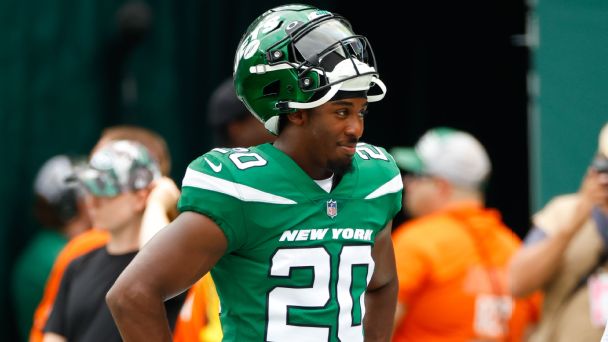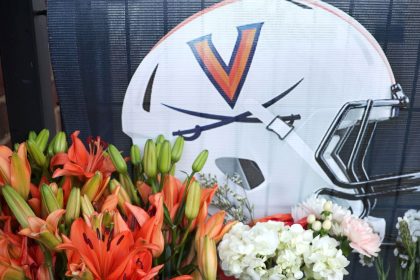
FLORHAM PARK, N.J. — A look at what’s happening around the New York Jets:
1. Targeting the opener: Continuity is rare in today’s NFL. Right now, the Jets have that in the backfield. They’re running it back with their top four backs from last season, an indication they expect Breece Hall to return to his pre-injury form when he averaged 5.8 yards per carry.
“Breece looks fantastic,” coach Robert Saleh said.
Hall, whose promising rookie year was derailed by a torn ACL in his left knee on Oct. 23, is expected to be ready for Week 1. Training camp appears unlikely — he will use the time for continued rehab — but lost practice time in July and August shouldn’t matter much. The whole idea is to get him ready for Sept. 10.
It’s hard to predict how a running back will respond from an ACL tear. (Hall also had a minor meniscus injury.) The New York Giants‘ Saquon Barkley had an ACL reconstruction and meniscus repair in September 2020, and he didn’t return to peak form until last season. On the flip side, there was Adrian Peterson, who ran for 2,097 yards in 2012 — a season that began eight months after he underwent reconstructive surgery.
The Jets’ production fell off a cliff last season after Hall was injured. With Hall, their running back group ranked 11th in rushing yards over expected (+78) in Weeks 1-7, per NFL Next Gen Stats. Without Hall, in Weeks 8-18, they dropped to 27th (-53). RYOE is a telling stat for running backs because offensive line blocking is factored in.
If Hall isn’t 100%, the Jets will rely heavily on Michael Carter, Zonovan “Bam” Knight and Ty Johnson, who re-signed on a one-year contract. An addition can’t be ruled out, either a free agent or a draft pick, but it probably wouldn’t be a significant move. Saleh seems content with the current cast.
“We love our running back room,” he said.
“[We] expect big things from Michael Carter,” Saleh added. “I know he had a down year a year ago, but I think he’s got a chance to come back strong. It usually happens where Year 3 is the trigger for those young guys. Obviously, Bam finished strong and we get Ty Johnson back.”
True, but Hall is the straw that stirs the drink.
2. Mike drop: Carter’s numbers were down significantly last season — 4.3 yards per carry in 2021 vs. 3.5 in 2022 — but he takes umbrage with the notion that he slipped.
“At the end of the day, it will make me a better player in Year 3,” he told ESPN at the end of the season, “but the narrative that I totally struggled my second year is false. When you’re put in a different role, you have different results.”
His role was smaller in 2022, as he lost carries to Hall and, later, Knight. After leading the team in rushing with 639 yards as a rookie, Carter rushed for 402 yards last year. Suffice it to say that 2023 will be pivotal for him.
3. Quinnen update: The Jets’ offseason program begins April 17. Barring an unforeseen development, star defensive tackle Quinnen Williams won’t be in attendance. At the end of the season, he went public with his demand for a contract extension, vowing to skip the voluntary workouts unless he has a new deal. Negotiations are ongoing, but no agreement is imminent.
4. Rodgers saga: It’s starting to feel like the Aaron Rodgers negotiations will go until the draft, when the pressure will be on the Green Bay Packers to do the trade. If not, they miss an opportunity to improve their roster with a 2023 draft pick (or picks) from the Jets.
Rodgers’ uncertain future — will he play beyond 2023? — appears to have complicated potential compensation packages. ESPN front-office insider Mike Tannenbaum suggested on “Get Up” a $60 million payout in 2024 to convince Rodgers to stick around for a second year. Under his existing contract, he’s due to make $49.3 million in ’24, which becomes fully guaranteed five days after the next Super Bowl.
Then again, we’re talking about a player who, if you believe him, was prepared to walk away from $59.5 million this year. Remember, Rodgers said he was “90% retired” before his darkness retreat in mid-February. Perhaps money isn’t his primary fuel.
No matter what happens, the Jets are well-positioned to absorb a major cap hit in ’24. They’re $86 million under the projected cap, according to Over the Cap.
5. Mini-mock 1.0: Setting up the Jets’ first pick at No. 13.
At No. 13 in this projection, the Jets have their choice of three highly rated tackles — Paris Johnson Jr. (Ohio State), Broderick Jones (Georgia) and Darnell Wright (Tennessee). At this point, we’ll go with Johnson because he’s more experienced than Jones and more versatile than Wright, who is seen mainly as a right tackle prospect. Van Ness or Smith would be tempting if they’re on the board; they’re always in the market for defensive linemen and edge players.
Trading down, something general manager Joe Douglas never has done in the first round, makes a lot of sense, especially if they want to replenish draft capital from a Rodgers trade.
6. Draft prep: The free agent additions of quarterback Tim Boyle and defensive tackle Quinton Jefferson follow a familiar script. Typically, Douglas plugs obvious holes with stop-gap players as the draft draws closer, reducing the temptation to reach to fill needs in the draft. He still has some plugging to do, though. They need reinforcements at center and linebacker.
7. Potential sleeper: Everybody loves a good long-shot story, right? For the next few months, keep an eye on wide receiver Irvin Charles, who made the practice squad last season as an undrafted free agent out of Indiana University (Pa.). He impressed last season on the practice field and has carried that momentum into the offseason with his studious approach. The team is stacked at receiver, but Charles (listed as 6-foot-4, 219 pounds) is big enough to be a flex tight end. Interesting prospect.
8. Safe at safety? After acquiring Chuck Clark in a trade with the Baltimore Ravens, the Jets might be content with the Clark-Jordan Whitehead combo at safety. Whitehead (two interceptions) was far from dynamic as an every-down player in 2022, but the internal hope is that his production will increase now that he’s had a year in the system.
Whitehead and Clark are similar players in that they’re both strong safeties, which could leave the defense vulnerable in pass coverage. The flip side is they will have two physical and durable safeties who play downhill in the box.
9. Tighter purse strings: A year ago, the Jets signed five free agents in the first wave, totalling $132 million in contracts and $74 million in guarantees. This year, they have added seven free agents for $59 million, including $30 million in guarantees. Two reasons for the change: Less cap room, plus an incoming quarterback contract (see: Rodgers).
10. The last word: “[He brings] gas. I know he ran a 4.3, but he plays at 4.3. He’s got elite, elite field vision with the ball in his hands. I think he’s second the NFL in YAC, behind only Deebo Samuel.” — Saleh on wide receiver Mecole Hardman and his potential impact









